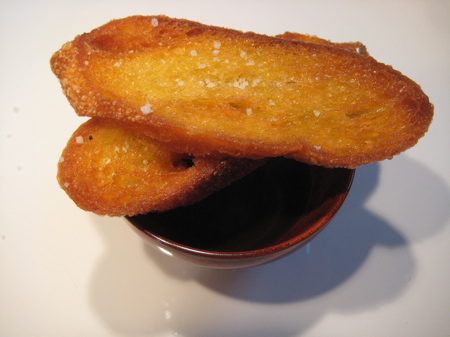
Teresa Parker blogs about restaurants, recipes, and the reasons why she's in love with Spain's food and culture.

We never made chocolate desserts when I was in cooking school in Barcelona twenty years ago. Don't get me wrong. The Catalans love the stuff, and so do the Spaniards: bread and chocolate have probably been the entire peninsula's favorite after-school snack since around 1500, when Cortez came back to Spain with a freighter-sized stash he got from the Aztecs. But my teachers frowned on chocolate as too heavy to take center stage in an after-dinner role.
I've had plenty of time back in the States to think about how to show off that thick, dark chocolate from Spain at dessert time. The first trick is in serving a dainty-looking portion. Properly made xocolata is intense, so an espresso cup full is plenty. As for the bread, having it toasty is an upgrade, more like a cookie alongside the chocolate (or dipped in). More so if you make toast the way my mother-in-law always did, by frying it to a glistening gold in olive oil.
I'm not just trying to avoid making cookies here: lots of big-time pastry chefs in Barcelona make bonbons filled with extra virgin olive oil. The fruitiness of the oil is amazingly good with chocolate. Sprinkle crunchy sea salt on the toast and now the whole thing is seriously mouth-watering.
You don't need any more of a recipe than that for this dessert if you can find a good Spanish or Catalan bar or grated chocolate mix marked a la taza or a la tassa or a la pedra. These are made especially for preparing hot chocolate — they're dark chocolate spiked with vanilla or cinnamon as well as a small amount of cornstarch, which thickens the finished hot drink to a consistency somewhere between hot chocolate and a pudding.
Of the brands available in the U.S., I like Blanxart. Just use the proportions on the package but keep in mind that since this dessert will be presented in demitasse cups you'll want to figure small servings (at most about 1/2 cup milk per person).
If you can't find the Blanxart or some other good chocolate from Catalonia or Spain, your Swiss Miss ain't gonna cut it. So just in case, here's a recipe that works perfectly as long as you have chocolate with 72% cocoa content.
Xocolata a la Tassa
Serves 10-12 demitasse portions
for the chocolate:
1 quart milk (whole or considering some versions of Spanish hot chocolate use water, 2% is fine)
10 ounces dark chocolate (72%)
2 Tablespoons cornstarch
1/4 teaspoon cinnamon
for the toasts:
1 baguette, sliced in 1/2 inch diagonal slices — figure 2 slices per person
about 2 cups olive oil (pour to 1/2 inch deep in a small skillet)
crunchy sea salt
Prepare the chocolate: Measure cornstarch into a small bowl. Break dark chocolate into a heavy saucepan. Pour a few tablespoons of milk into the bowl with the cornstarch and stir to dissolve.
Pour the rest of the milk into the saucepan with the chocolate, add the cinnamon, and bring the mixture to a very gentle simmer, whisking frequently to incorporate the melting chocolate well. You may notice tiny grains of dark chocolate, but keep whisking and know that adding the thickener will perfect the emulsion.
Add the cornstarch-milk mixture, whisking constantly and allowing the chocolate to come to a gentle boil for about one minute (you want to cook off the raw cornstarch flavor but overcooking will make the cornstarch lose its thickening power).
Serve hot or let stand and refrigerate to serve later. A skin will form on the surface of the chocolate, but whisk it in when you reheat and all will be well.
Prepare the toast garnish: Slice baguette into 1/2 inch diagonal slices, figuring two slices per serving.
Heat about 1/2 inch olive oil in a small skillet -- don't let it get to the point of smoking, just let it get hot enough to make a test toast brown gradually.
Fry the toasts, turning once to get them golden brown on both sides. Remove, sprinkle toasts with a pinch of sea salt, and place over or beside the chocolate cups. These are best fried just before serving dessert.

Comments
Miriam/El invit... replied on Permalink
How come that it took me so long to discover your blog? Shame on me...